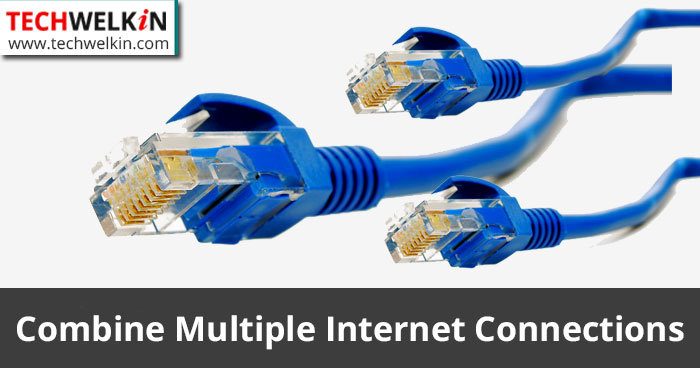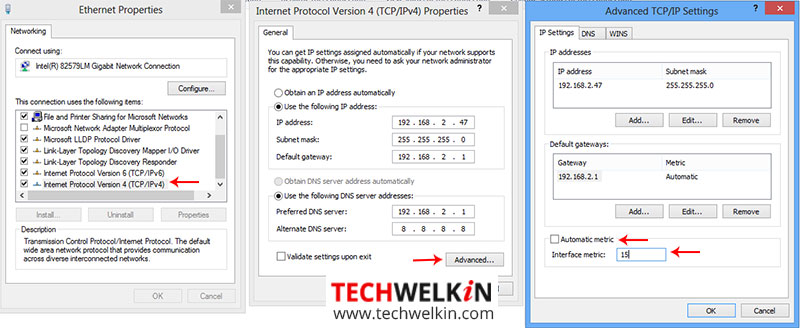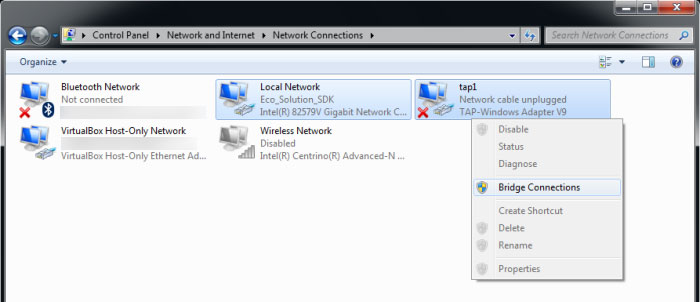Last evening a colleague asked if it was possible to combine two Internet connections to increase overall download speed? The idea seemed logical and the good thing is that the answer is yes! We can join two or more Internet connections to add up their individual speeds.
Having multiple active Internet connections and using just one of them to download a big file is not a very efficient way. Suppose, you have two connections of 1 MBPS speed and you’re downloading a high quality 2GB movie file. You can combine both your connections to get a speed of around 2 MBPS and thus you will be able to watch your movie sooner! In this article we will learn how you can combine Internet connections. You can join them regardless of their type — wired LAN/WAN, wifi connection or mobile Internet (3G/4G etc). Your connections may be from different ISPs but you can still join them.
Before We Begin
Let’s first understand some background stuff. Combining Internet connections is achieved by load balancing wherein a computer uses multiple IP addresses to download data. Load balancing can be done using both software or hardware. However, combined connection can be used only by those software that support such a connection. For example, the following actions can make use of the combine Internet connection:
- Torrent clients (to download movies, software etc.)
- Web browsers (your surfing speed will increase)
- YouTube (no more buffering!)
- Download Managers (speedier downloads)
Total data usage will be according to the individual connection usage. So, total usage will be the sum of the usage from individual connections.

Method 1: Set Windows Automatic Metric to Combine Connections
Note: with this method you can combine the following types of connections: Bluetooth Modem, Mobile Broadband, OTA Modem, Dial-Up
Windows operating system has a metric value that is assign to an IP route to indicate the cost associated with using that route. When you have multiple active Internet connections on your computer, Windows automatically computes the cost of using them and assign a metric value to each of them. Then Windows set the most cost effective connection as default and keeps other active connections for backup (fail safe) purpose.
You can manually assign this metric value. If you set this value the same for all active connections you can force Windows to use all the connections.
- Open Control Panel
- Go to Network and Sharing Center > Change Adapter Settings
- Double click on your active Internet connection
- Select Internet Protocol TCP/IP Version 4
- Click on Properties button.
- A new box will open. Click on Advance button
- Another box will come up. Uncheck Automatic Metric
- Type value 15 in the box labelled Interface metric.
- Repeat the above steps for all the active connections your have
- Disconnect all your connections
- Restart your computer and reconnect all the Internet connections
That’s it! You will have the combined the power of all your Internet connections!

Method 2: Use Bridge Connections Feature of Windows
Note: This method should be used for combining LAN/WAN connection
Windows also provides a feature of bridging connections. To use this feature, you have to have at least two active LAN/WAN connections on your computer.
- Open Control Panel
- Go to Network and Sharing Center
- Here you will see all the available active Internet connection
- Select all the active connection (use CTRL+Click to select multiple connections)
- Right click on one of the selected connections and choose Bridge Connections
- A network bridge will be created and thus your selected Internet connections will be combined.

Note: You may have to provide administrative credentials in order to do this bridging.
Method 3: Combine Internet Connections With Load Balancing Router
Several load balancing routers are available in the market. When you search for it in Google, TL-R480T+ comes as the first choice. There are routers from better known companies like Cisco as well. But load balancing router from TP-Link is cheapest and could be affordable by individuals and small businesses.

This router providers 4 WAN ports where you can plug in up to four wired connections. This piece of hardware comes with built-in advanced algorithm that guarantees maximum Internet speed after you combine several connections.
TL-R480T+ router is available for about $65 at present. Join all your connections and then output them as one single connection. Then you can distribute the combined speed through a wifi router, LAN hub or you can directly connect it to your computer.
After running the setup of the router, go to the configuration page as instructed in the user manual.
- Go to Advanced > Load Balancing option
- Uncheck Enable Application Optimized Routing option
- Uncheck Enable Bandwidth Based Balance Routing option
- You should also set the Maximum Transmission Unit (MTU) of router to avoid timeout errors.
- Make sure that the IP address assigned to load balancing router is different from the default gateway address of the WAN connections. The default IP of router is 192.186.0.1 (as usual)… change your default gateway IP if it is the same.
Method 4: Use Third Party Software to Combine Internet Connections
Download Connetify and install it on your computer (requires Windows 8 or above). This third party software offers you two programs:
- Connectify Hotspot: this program converts your wifi-enabled computer into an Internet hotspot — so that other people can also use the Internet connection from your computer.
- Connectify Dispatch: this program combines Internet connections available on your computer.
At present, we are interested in Connectify Dispatch. So, after installation, run this program and connect all you Internet connections. That’s all… your Internet connections will join forces to give you superfast speed!
We hope that this article on joining the available Internet connections was useful for you. Should you have any questions or suggestions, please use the comments area. Thank you for using TechWelkin!

I ended up making my own software. I can connect up to 4 different internet connections using both WiFi and LAN.
It is a basic UI where you choose your preferred internet and let it connect. Once connected the line goes green and displays the actual local and WAN ping & IP address.
Then if you have other Wifi &/or ethernet connection you click in the dropbox the order in which you prefer, but it doesn’t matter much. Just if the primary one fails it drops out. Then reconnects all.
So, I connect to my main home Wifi then using my phone connect to the 5G or 4G network (I have a lot of data). Then I have my motherboard ethernet connect to a separate internet and sometimes I use a pci network card to connect to another provider.
In the end the latency/ping you will get is totally dependent on the primary but the combined speed of all connections only add 2-5ms of latency but it downloads over 2000Mbps (or 250 megabytes per second).
I’m sure there is software out there that has done it better, but my code just works. My NVME drive gets a brief workout when downloading large files, but the beauty is I can still game with a ping of 3-25ms within Australia and have anything downloading in the background without issue
How to combine internet on Android device !?
will this work on upload speeds as well
can i connect mobile hotspot and internet 4g device on computer for boost internet speed kindly reply please ?
In a suitation I do not have two different network card. How do I go about using TPLink LS1008G? Can the two router internet be connected to the switch and works same way as explained above? Thank you.
in your case then you will not be combining the speed of two networks – you will just be dividing your traffic between two wires as it goes to your one internet connection. You will not get speed increase, and in fact will slow your connection to the one network connection you do have.
Just wanted to thank you for these helpful tutorials.
Desired Topology
ADSL2+ Modem 1 } ——+
|
} Load Balance Router —–> Home Router } 8 switches (one per room) each with their own devices, including wifi mesh
|
ADSL2+ Modem 2 } —–+
Is this correct usage before I invest time acquiring and configuring a TL-R480T+ ?
Much appreciated
Hi,
Thank you for sharing this awesome tutorial.
I have a question regarding the legal implications of this practice as i am a student starting university this September.
The network page says that i am allowed to connect up to 5 devices and each one is entitled to 30 Mbps.
In your opinion, do you think there is any risk in using this on a university network?
Network professional here. I believe as long as you are following TOS for content and use of the network as you normally would you will be fine. I think even if the savviest admin might notice some odd clusters of packets moving from an external IP to a select group of clients, it would be awful tough to distinguish from regular traffic. It would have to be regular and heavy and impactful for me to even be remotely curious, as no single connection is able to exceed QoS bandwidth caps. Most of your traffic from a server is going to be sent to a single IP regardless. What this will allow you to do is send and receive packets from various other protocols and IPs simultaneously giving you a net bandwidth increase, but not necessarily with downstream exceeding 30MB from any given connection, as they may not be multiplexed over multiple IPs. I’m not really a layer 2 guy but that is my thinking. As for legality, you are entitled to 5 connections, each of which are capped and so on. I would think that you can use them however you like. The very worst I would expect is a talking to with some genuinely curious inquiry from the help desk :)
Are any of these methods compatible with VPN?
Thank you for the excellent article!
How can you exceed your streaming speed? There’s no transport layer protocol – that I’m aware of – that will let several clients receive partially the same data.
UDP and bittorrent can actually make decent use of multiple connections. UDP is just gonna spam bits at whatever IP makes a request, which can easily vary in real time on the fly and is simply fed to the next layer in the network stack. Doesn’t matter where it came from at that point and server is not the least bit concerned with whether or not all the bits it spammed were received. There may be redundant data transferred but software layer doesn’t really care if it discards some packets, it does that already. Alternatively, p2p/bittorrent is distributed over multiple connections already, although you are correct that no client is receiving partial data as no packets are being split, each request is fulfilled over the connection it was made on, and no single connection is exceeding its bandwidth, that would be true witchcraft indeed. TCP however is not going to just work like that. Software would have to split up packets and reassemble, and client and server software would have to be… on the same page about the procedure because as you said, tcp/ip is not inherently divided over multiple clients. It’s lower level than that. All it does it to make sure you got your packets as requested/served by the next higher level over the interface that request was made on. TCP/IP is at the level of the interface itself.. Simply, every individual outgoing request can now be made on theoretically the most optimal connection at the time the request is made by software. Some software and protocols work better for this.
Hello,
First Thank you for your time in sharing your experiance
Second, I got a firewall ( Sonic Wall ) & used it as network combiner & I need to upload videos with high bit rate for good quality, but I find that it Just uses 1 line from all the 3 i am connecting
Can I combine them together & get there full speed
if yes, how?
Thank you
To confirm this is working you will need some way to see if each of your internet services are being used. I have two Cisco ASA appliances and so I can see each of the Internet Connections bandwidth being used. Hopefully you have a way to see the traffic on each of your routers.
In any case, now open a web browser and download your favorite video or large file. Open a second web browser and download your other favorite movie or file. You can keep doing this over and over. On my network I had 20 movies being downloaded and both Internet Connections were downloading at full speed for hours. This should work for most downloading, as long as you invoke a new download from multiple applications, FTP, Torrent, etc.
One last note, I forgot to mention that your Ethernet Adapters (wireless or wired) will have different LAN ip addresses, and different gateway addresses. When you save the TCP / IP settings, windows might warn you about multiple gateways. Just ignore the warning and save the settings.
Cherio!
Configuration for Windows 7, (Should work on later versions).
You need two Internet (or more) Connections. Wireless or Wired.
You need two Network Adapters (or more), each Network adapter needs to have a fixed IP address, (Do not use DHCP assigned).
Each Adapter needs to have the gateway set properly for each Internet Connection. Open each Network card settings and go into Internet Protocol Version 4 Settings, click on Properties, make sure you have Fixed IP values correct, and Default Gateway set to your first ISP’s gateway. Click on Advanced
uncheck the Automatic Metric, and put in 15 (The number 15 doesn’t matter just use the same number for all metrics). Important!!! There are two places to enter the metric. Don’t use automatic metric anywhere. If the Default Gateways: is empty, add the Gateway and set the metric to 15 in there as well. Save all that.
Now do the same thing for the second Internet Connection, again the gateway will be different, and make sure you have the metric set to 15 on this adapter as well in both places. If you try this with DHCP, my Windows 7 computer would work for a short period, and then the Gateway metric would get removed. Once I used a static IP, windows doesn’t remove the Default Gateways: metric setting.
The reason this works is because you have set the metrics to 15, windows will use the least busy network card because they both have the same metric. Usually a network interface card have different metrics, and windows can choose the card with the best metric.
This setup works the best if both your Internet connections are of the same speeds.
So not a perfect solution, but it’s cheap and free.
2020-02-28
Method #1 does work, with some caveats:
What it does work:
1. If you start a download (using Web Browser), or most any application that downloads files. The first download will start on the first connection. If you open another connection and download another file, the second download will be downloaded using the second internet connection.
What does not work:
If you run a speed test you will only get the connection speed of one of the adapters, not both.
However, this is quite useful if you download multiple files. Opening multiple applications (web browsers, FTP, Torrent clients) etc.
I’ll post another comment explaining requirements.
Could you please tell me , How can i combine with load balancing router two PPPoE Server connection ??
I have taken two different ISP ,and both is PPPoE Server .
Great . thank you very much. i have to mention that bridging did not work. It was only choosing one connection. but setting interface metric worked.
none of these methods worked for me. inetfusion software did though. it combined two of my wifi together. faster speed.